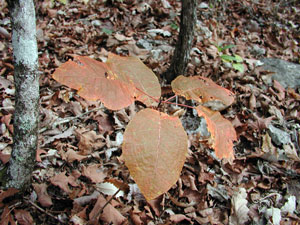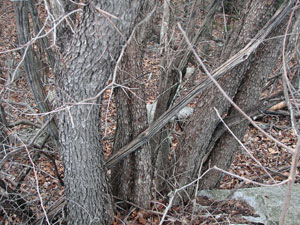Resource Library
Plant of the Week: Chittamwood
The University of Arkansas System Division of Agriculture does not promote, support or recommend plants featured in "Plant of the Week." Please consult your local Extension office for plants suitable for your region.
Plant of the Week
Chittamwood
Latin: Cotinus obovatus

My small city garden scarcely has room for another tree, but last fall I succumbed to temptation and added just one more. The tree was the American smoketree, or chittamwood, Cotinus obovatus. I convinced myself that it is by nature a small tree, and I will keep it pruned. Such self-delusion may one day lead to a train wreck, but 'til then I will enjoy my new addition and watch it grow and develop.
Chittamwood is a medium-sized deciduous shrubby tree growing to 30 to 35 feet tall and wide with a rounded crown. Trees have a few large branches and are decidedly not twiggy in nature, and clearly show their kinship to the sumac family, where they belong. On old specimens, the bark of the tree is gray-brown with upturned scales reminiscent of fish scales dried in the sun.
The blue-green leaves are elliptical in outline with a long petiole and 4 to 5 inches long, with the leaf blade usually 1½ to 2 inches wide. The margins are not marked with serration. Fall color is a strong yellow to orange or even deep red, depending on the site and the genetics of the particular specimen. Mike Dirr from Georgia considers this species perhaps the best fall color-producing tree throughout the South and Midwest.
Chittamwood produces panicles of small whitish blooms at the ends of branches in early summer, giving the tree a kind of smoky look when in bloom. The trees are dioecious, with the male plants having larger and showier blooms than female trees, but even then the panicles are usually only around 8 inches long. Our native American smoketree (chittamwood) has a more restrained flowering display than the common smoketree (Cotinus coggygria) of China, but I personally like the floral effect of our native species better.

Five species of Cotinus are known throughout the world, with only this species found in North America. It occurs on limestone outcrops with its widest distribution in the Ozarks, including the eastern part of Oklahoma. It also occurs in a narrow band on limestone bluffs in the Hill Country of central Texas, and in a band from northeastern Alabama and adjacent areas of Tennessee. It will grow in more acidic soils, but seems to thrive best with a near-neutral pH. Plants are extremely drought tolerant once established.
Chittamwood is a name shared by several divergent species of plants in both the Old World and New, and probably dates back to Biblical times, where a similar word was used to describe a kind of acacia known to have heavy, dense wood. Smoketree wood is bright yellow, hard and heavy. The plant was cut heavily during the Civil War years and used to extract a yellow dye.
The American smoketree is a more understated plant than its more common Asian cousin. It lacks the purple (or now yellow) foliage of the Asian species, but in exchange has better fall color. And it is more treelike in habit, making it easier to accommodate in the home landscape than the Asian species, which tends to be a big, wide spreading shrub. To date, no vegetatively propagated cultivars of our native species are commonly available, though a number of clones are offered of the Asian species.
Chittamwood is an excellent small specimen tree in the garden, or can be used as a background component in the shrub border. Though I have not seen it used this way, it should be an excellent choice for small parking lot islands, where root run is limited and established plantings often ignored. It grows in any average, well-drained garden soil and has considerable heat and drought tolerance once established.
By: Gerald Klingaman, retired
Retired Extension Horticulturist - Ornamentals
Extension News - June 3, 2011
The University of Arkansas System Division of Agriculture does not maintain lists of retail outlets where these plants can be purchased. Please check your local nursery or other retail outlets to ask about the availability of these plants for your growing area.